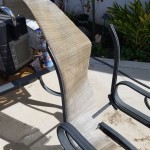How to Clean Paving Slabs on Patio Pavers: A Comprehensive Step-by-Step Guide
Paving slabs on patios and other outdoor areas provide a durable and aesthetically pleasing surface. However, over time, they can become dirty, stained, or covered with moss and lichen. Regular cleaning is essential to maintain their appearance and prevent premature deterioration. Here's a comprehensive guide on how to clean paving slabs on patio pavers effectively and safely.
Materials You'll Need:
- Bucket or garden hose
- Stiff broom or brush
- Detergent or paving slab cleaner
- Pressure washer (optional)
- Sand or jointing compound (for re-sanding)
- Sealer (optional)
Safety Precautions:
Before starting, take necessary safety precautions. Wear gloves to protect your hands from chemicals and sharp objects. If using a pressure washer, always wear safety glasses to prevent eye injuries.
Step 1: Remove Loose Dirt and Debris
Use a stiff broom or brush to sweep away loose dirt, leaves, and other debris from the paving slabs. This will help remove surface dirt and make the subsequent cleaning steps more effective.
Step 2: Prepare a Cleaning Solution
Fill a bucket or garden hose with water and add a suitable cleaning agent. You can use a mild detergent, paving slab cleaner, or commercial cleaners specifically designed for outdoor surfaces. Follow the manufacturer's instructions for the recommended dilution ratio.
Step 3: Apply the Cleaning Solution
Apply the cleaning solution to the paving slabs using a broom or sponge. Work in small sections to ensure even coverage. Scrub the slabs thoroughly with the brush, paying attention to areas with stubborn stains or dirt. Avoid using excessive force, as this can damage the surface of the slabs.
Step 4: Rinse the Slabs
Once the cleaning solution has been allowed to dwell on the slabs for a few minutes, rinse them thoroughly with clean water. Use a garden hose or power washer to remove all traces of the cleaning solution and dirt. If using a pressure washer, hold the nozzle at a 45-degree angle and avoid using high pressure, as this can damage the pavers.
Step 5: Re-Sand if Necessary
Over time, the sand between paving slabs can become compacted or washed away. After cleaning, check the joints between the slabs and re-sand them if necessary. Use a brush or broom to distribute the sand evenly and compact it using a rubber mallet.
Step 6: Seal the Slabs (Optional)
To protect the paving slabs from future stains and damage, consider sealing them with a commercial sealant. Follow the manufacturer's instructions for application and drying time. Sealing will enhance the lifespan of the pavers and make future cleaning easier.
Additional Tips:
Clean paving slabs regularly to prevent dirt and debris from accumulating. Regular cleaning will make future cleaning tasks easier.
For stubborn stains, such as oil or paint, use a dedicated stain remover specifically designed for outdoor surfaces. Always test the stain remover on a small, inconspicuous area before applying it to the entire surface.
Avoid using harsh chemicals or acidic cleaners, as these can damage the paving slabs. Instead, opt for mild detergents or paving slab cleaners that are safe for outdoor use.
When cleaning with a pressure washer, be sure to keep the nozzle at a distance from the surface to prevent damage. Always follow the manufacturer's instructions for safe operation.

How To Clean Patio Slabs Minster Paving

How To Clean Paving Patios A Comprehensive Guide Awbs

How To Clean Paving Slabs With Bleach Water Directory

How To Clean Paving Slabs With Bleach Water Directory

How To Clean Patio Slabs Kärcher International

How To Clean Paving Slabs With Bleach Water Directory

Best Tips On Cleaning Patio Slabs How To Get Rid Of Algae

How To Clean Patio Pavers For A Stunning Stone Epic Stoneworks

3 Ways To Clean A Stone Patio Wikihow

How To Clean Paving Slabs With Bleach Water Directory
See Also








